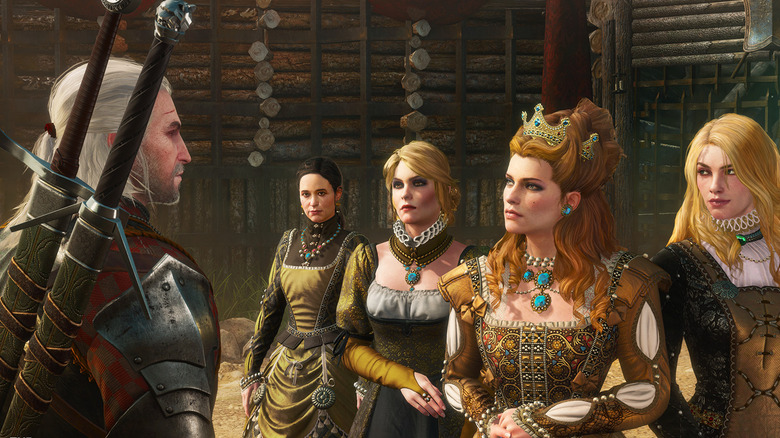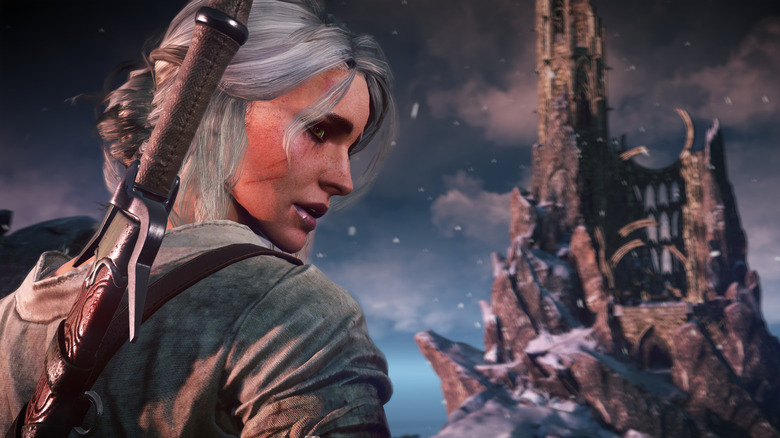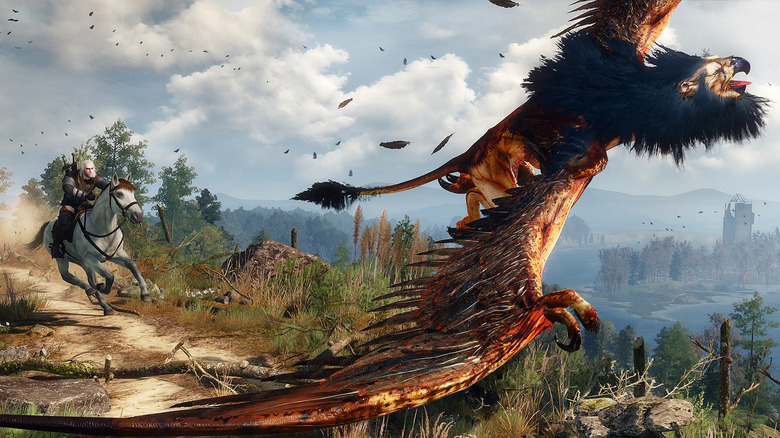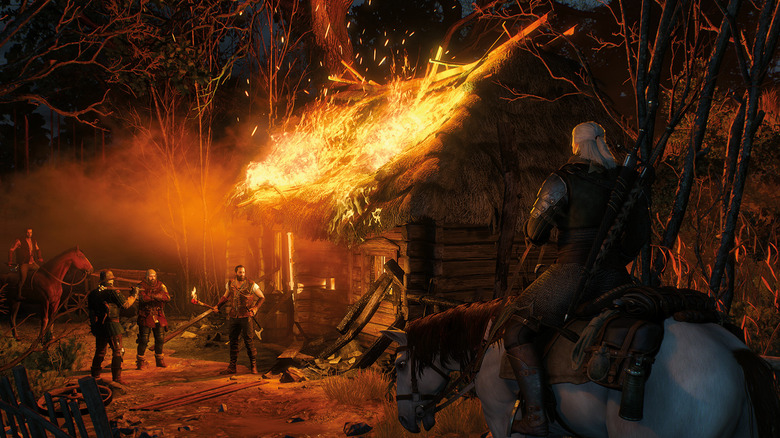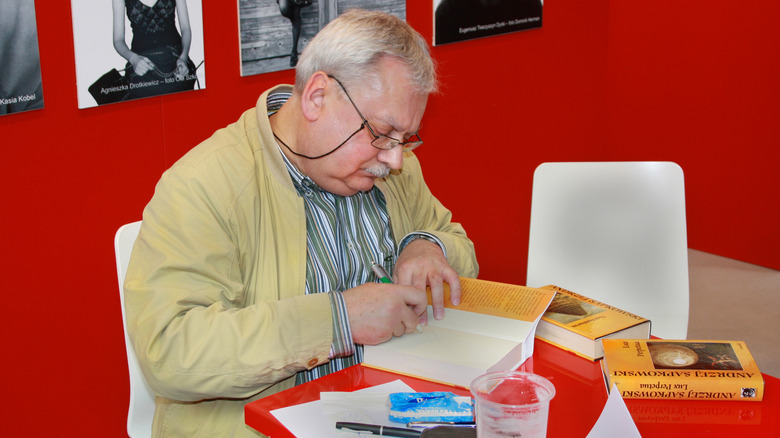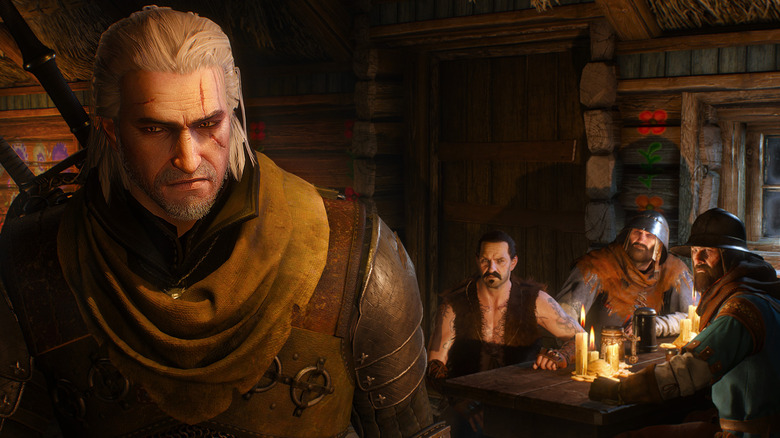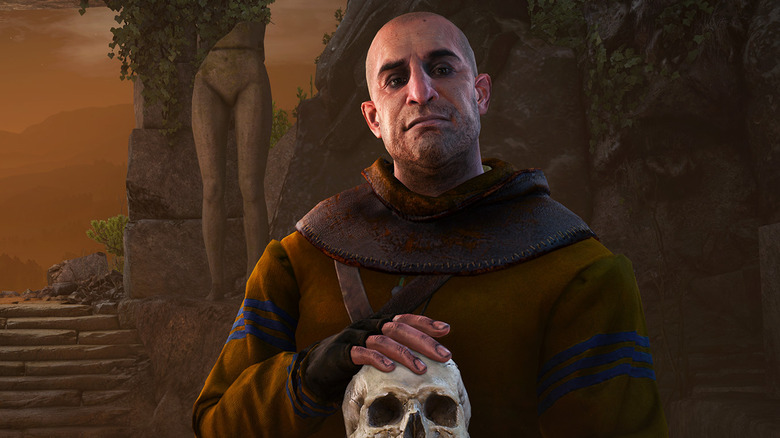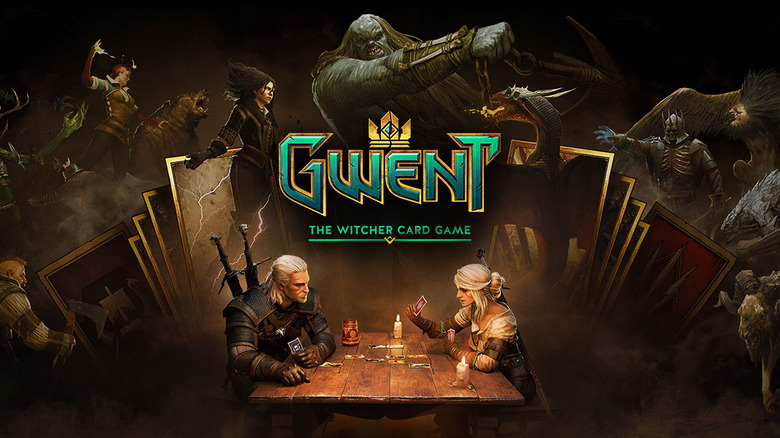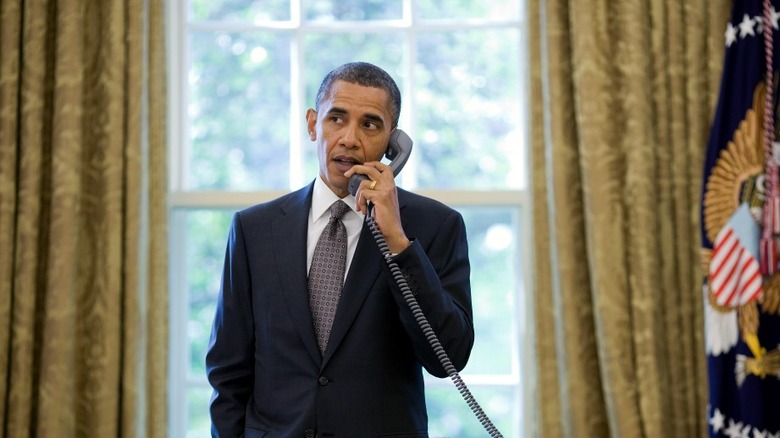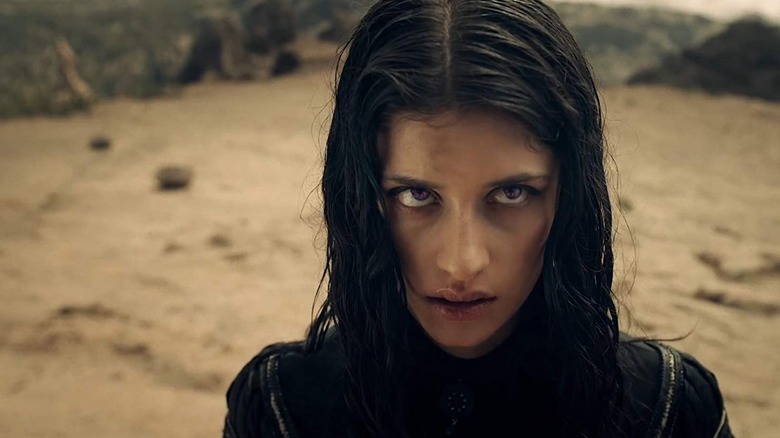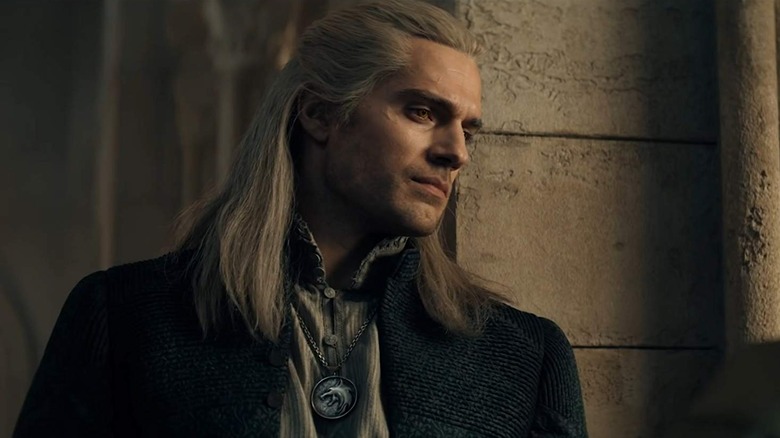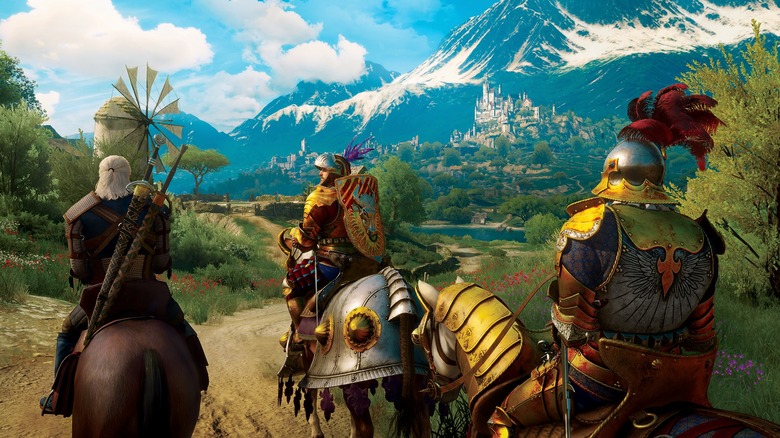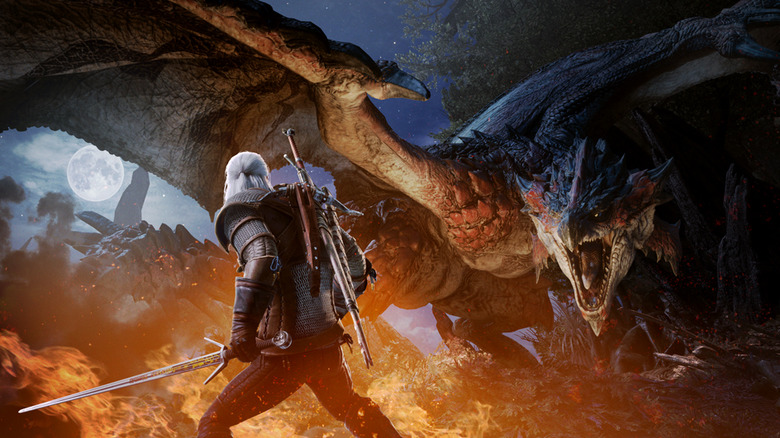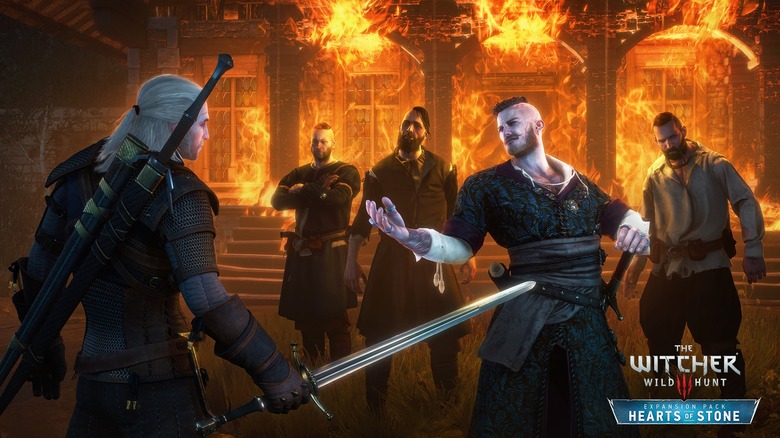The Untold Truth Of The Witcher
We may receive a commission on purchases made from links.
Many of Geralt of Rivia's fans were first introduced to the gravelly-voiced hero by the Witcher video game trilogy. The first Witcher title was released for PC in 2007, the series really took off in 2011 with The Witcher 2: Assassins of Kings, and The Witcher 3: Wild Hunt was one of the best reviewed titles of 2015. According to CD Projekt Red's 2017 financial records, the open-world dark fairy tale trilogy has sold over 33 million copies.
Geralt, Yennefer, Triss, and the rest of the crew have actually been around since the 1980s, when Polish author Andrzej Sapkowski entered a short story contest with "Wiedzmin," translated to "The Witcher." Eurogamer reports that Sapkowski's story nearly won the grand prize, and he has since gone on to write dozens of stories and novels that follow the story of the Butcher of Blaviken. So if your only experience with the Witcher series comes from the games, then you've come to the right place. Here are some of the lesser-known aspects of The Witcher.
Geralt and Ciri were brought together for a surprising reason
If you don't follow the backstory of The Witcher too much, you may be confused about Geralt and Ciri's relationship. Witchers are sterile, yet Geralt refers to Ciri as his daughter. Meanwhile, Emperor Emhyr var Emreis also claims she is his child. So what's the story here, and why does Ciri get trained at Kaer Morhen? First, we need to talk about the "Law of Surprise."
In the lore of The Witcher, a Witcher like Geralt never works for free. However, they will sometimes invoke the Law of Surprise after performing a good deed rather than demanding a traditional payment. This Law of Surprise states that the first thing to surprise the person when they return home will actually belong to the Witcher who invoked the law, and, in rare occasions, that surprise can wind up being a child.
Ciri is the biological daughter of van Emreis, but Geralt saved his life and utilized the Law of Surprise. When van Emreis returned home, his wife greeted him with news of her pregnancy. Geralt actually claimed Ciri again when she had been taken in by a merchant family and he saved yet another man's life. It was only after this second occasion that Geralt decided fate was intervening and took Ciri back to Kaer Morhen.
Sometimes, serendipity just works out.
The Witcher 3 references a lot of other fantasy and sci-fi properties
Obviously, the world of The Witcher 3: Wild Hunt is absolutely massive, and CD Projekt Red has hidden all sorts of fun Easter eggs throughout Novigrad, Skellige, and the like. This is just a small sampling of the pop culture references you can find throughout your journey.
Of course Geralt would want to poke some fun at the world of Game of Thrones. PC Gamer writes that, in their version of the story, Tyrion Lannister never earns his freedom from the sky cells at the Eyrie. In an out of the way fort, players can find a set of prison keys, and one of the cells therein holds the corpse of a little person with a nasty facial scar.
For a little sillier take on medieval fantasy, Reddit user KylosProdigy discovered a cave entrance covered in blood and corpses. Sitting in the middle of the carnage was a tiny white rabbit, straight out of Monty Python and the Holy Grail.
It is not only medieval fantasy to be found in the Witcher. YouTuber xGarbett posted a video showing where players can encounter the Weeping Angels of Doctor Who. Not even Geralt is quick enough to fight off those beasts.
There are plenty of other Easter eggs to be found in the massive worlds of The Witcher. You wouldn't want to miss them, so try not to blink.
A living sword master helped create Geralt's dance-like fighting style
Geralt is easily one of the most formidable fighters alive in the universe of The Witcher, and his sword fighting style was actually created especially for the game. And the main man who put it together, based off the descriptions in Sapkowski's original stories, is a stunt man named Maciej Kwiatkowski. According to his IMDb page, he has also worked on other video games like Shadow Warrior 2 and he coordinated the fights in the film King Arthur: Legend of the Sword.
Game Informer ran a short feature on the motion capture work that went into The Witcher 3: Wild Hunt, and showcases Kwiatkowski in action. Geralt uses his superhuman speed and reflexes to avoid the attacks of huge monsters and otherworldly creatures, so Kwiatkowski incorporates a lot of spins and pirouettes into his style. The video above not only features a breakdown of why they made the design choices they did, but also shows some pretty cool footage of Kwiatkowski pulling off the unique fighting style that Geralt uses throughout the series.
The Wild Hunt is ancient Slavic mythology and appeared in Grimm's fairy tales
The primary antagonists of The Witcher 3 are the "Wild Hunt," a frightening group of ghostly riders who pursue Geralt's former ward Ciri. Like many of the creatures that inhabit Geralt's world, the Wild Hunt are actually based on traditional Germanic, Norse, and Slavic folklore, and their name was actually popularized by Jacob Grimm in the early 1800s.
The Wild Hunt is traditionally depicted as a group of elves riding spectral steeds through the sky and leaving frost in their wake. Mythology.net describes the story evolving throughout the centuries, especially the leader of the Wild Hunt: in different versions and areas of the world, it is sometimes Charlemagne, King Arthur, or Frederick Barbarossa riding at the head. Odin, king of the Norse gods, is also often described as the leader of the Wild Hunt.
R.E. Hutton writes that, like many well-known modern myths, the version of the Wild Hunt that is still known today is most likely an amalgamation of several different stories. Obviously, The Witcher put its own spin on that mythology to bring us the imposing elves who relentlessly pursue Ciri.
The creator of The Witcher has made almost nothing off the video games
The creator of the characters of The Witcher, Andrzej Sapkowski, actually had no hand in developing the story of the games. He merely sold the rights of his creation to CD Projekt Red, and you would expect that he has enjoyed a steady stream of royalty checks due to the massive success and acclaim that the games have accrued.
Unfortunately for Sapkowski, he has not seen a cent of the games' profits since the initial transaction.
According to an interview with Eurogamer, Sapkowski says that CD Projekt Red approached him with a "big bag of money" and asked if they could use his characters in their upcoming video game. Sapkowski had never thought much of video games and assumed it would be a terrible failure, so he took the up front offer and did not demand any royalties. He realizes now how much money he left on the table, but he is not too bitter about it. Speaking about the developers, he told Eurogamer, "I didn't believe in their success ... They merit all the beneficiaries they get from it. They merit it. The game is very good."
Poland, where the series originated, has a Witcher musical
By now, you're probably aware that a Witcher television series is headed to Netflix. Some fans even more in the know might have heard of the Polish series The Hexer, which also brings Sapkowski's characters to life.
Did you know that there is a live stage musical featuring Geralt, Ciri, and Yennefer?
That's right: a Witcher musical opened in Poland in November of 2017, and it is not some amateur hour production. Eurogamer writes that the show features up to fifty-one people on stage at a time, with actors, acrobats, and dancers included. There is a full orchestra playing the score, and some scenes even feature breakdancers.
The show is a direct adaptation of a few of Sapkowski's short stories, taken from his anthologies The Last Wish and The Sword of Destiny. Unfortunately, Eurogamer writes that the musical was only scheduled to run through May 2018. The show may be over, but hopefully an off-Broadway English translation is in the works.
Gaunter O'Dimm was right in front of you all along
At first glance, Gaunter O'Dimm may look and seem like an ordinary, unassuming man. He claims to be traveling salesman, but the "Master of Mirrors" is much more than he initially seems. O'Dimm actually appears near the very beginning of The Witcher 3, speaking with Geralt in a White Orchard inn and pointing him in the right direction. He then mysteriously mentions that he may call on Geralt again someday.
Fast forward to the Hearts of Stone expansion, and O'Dimm saves Geralt's life in exchange for a small favor. Turns out O'Dimm is an all-powerful, Faustian figure who delights in trading for peoples' souls, and if you aren't as eagle-eyed as our master Witcher, you may never notice that O'Dimm keeps a close eye on you throughout the entire storyline.
Kotaku reports that CD Projekt Red actually ran a fan contest to see if anyone could spot O'Dimm every time he appears in the background of different scenes throughout the Hearts of Stone story. Not one person was able to identify every instance, and CD Projekt Red had to release screenshots showing every disguise the seriously creepy O'Dimm dons to keep track of your progress. Turns out the devil really is in the details.
Gwent was created in just three days
You probably remember Gwent as either "that silly card game attached to the awesomeness that is The Witcher 3" or "that silly card game that I spent more time playing than the actual game it was a part of." Regardless of how you remember it, Gwent has since spun off into its own eSports title, complete with a prize pool of several hundred thousand dollars. Not bad for a side project that was thrown together in three days.
A Twinfinite article writes about the development of Gwent, and how it was created for a few different reasons. The developers of Gwent, Damien Monnier and Rafal Jaki, wanted to give players a break from fighting, create a collectible aspect to The Witcher, and help make the world more realistic by giving its citizens a hobby. They were given the go-ahead to create Gwent (which is mentioned in Sapkowski's original stories), but only if they could put it together in three days.
The two got to work, and quickly hammered out the basics. A bit of coding and some good fortune later, and CD Projekt Red had the most addictive side quest card game since Triple Triad.
President Obama received a copy of The Witcher 2
You might be surprised to find that Poland's leadership views The Witcher as one of the best ambassadors to the world for what the country has to offer. On an official state visit in 2011, United States President Barack Obama was given a copy of The Witcher 2: Assassins of Kings by Polish Prime Minister Donald Tusk. Business Insider reports that he said this about the gift:
"The last time I was here, Donald [Tusk] gave me a gift, the video game developed here in Poland that's won fans the world over, The Witcher. I confess: I'm not very good at video games, but I've been told that it is a great example of Poland's place in the new global economy. And it's a tribute to the talents and work ethic of the Polish people as well as the wise stewardship of Polish leaders like Prime Minister Turk."
It's unfortunate that Obama did not play through the game and highlight his favorite quest lines, but there you have it: The Witcher is a gift fit for world leaders. Dijkstra would be proud.
The Netflix adaptation will feature some well-known talent
The Netflix adaptation of The Witcher has generated quite a bit of buzz, and we've finally got some serious casting information. By now, the main three actors (Henry Cavill as Geralt, Freya Allan as Ciri, and Anya Chalotra as Yennefer) have been pretty well picked over. However, the supporting cast for the show is also impressive, and gives us an idea of what other plotlines might be explored.
One interesting casting choice is Anna Shafer as Triss Merigold. Shafer's first ever acting role was as Romilda Vane in the Harry Potter franchise, and she has appeared in several other British productions as well. Triss is a major character in the video game version of Geralt's story, so it will be interesting to see how large a role the sorceress plays on the show. Joey Batey (Knightfall) will also appear as "Jaskier," the original Polish name for Dandelion (which actually translates to "Buttercup").
Plenty of other characters from the game will appear as well. Shaun Dooley (Broadchurch) is set to appear in a few episodes as King Foltest, Mimi Ndiweni (The Legend of Tarzan) will play the sorceress Fringilla, and Adam Levy (Before I Go to Sleep) will play the druid Mousesack, also known as Ermion.
Henry Cavill is a Witcher superfan
Henry Cavill really, really, really wanted to play Geralt. As soon as he found out the show was being made, he did everything he could to land the role. His central strategy? Geralt himself might call it "tenacity," but we'll let showrunner Lauren Schmidt Hissrich sum it up: "He was really annoying. I finally said, 'I will meet with you. The show is not green-lit. There is nothing.'"
Even though the show had not been written yet, Cavill repeatedly bugged his agent about getting him in front of the showrunners, and it finally paid off once it was all said and done.
Cavill is taking the role very seriously; he refused to use a stunt double and trained regularly so he could do his own swordfighting. He has also played through The Witcher 3: Wild Hunt multiple times, and looks forward to putting his own spin on the legendary monster hunter. He told IGN it was like playing the game a slightly different way: "OK, cool, I've done it, I've seen it, and I still get that enjoyment of playing it through, but what if I could play it slightly differently."
The Witcher 4 will (allegedly) not be a continuation of Geralt's story
We don't know for sure that a fourth Witcher video game is coming our way; CD Projekt Red is all hands on deck working on Cyberpunk 2077 at the moment. But considering what a massive success the games have been — especially Wild Hunt, which won dozens of awards — and what a huge brand The Witcher seems set to become, it isn't hard to imagine a fourth game is at least in the conceptual stage.
Don't get your hopes up for more Geralt, however.
Speaking with Polygon when promoting The Witcher 3, Marcin Iwinski, the CEO of CD Projekt Red, explained that the series was always meant to be a trilogy about Geralt of Rivia: "We are not killing the world and walking away from it, but we will definitely want to make this game the finale in a big way ... We might even include Geralt in later games potentially. We just need to talk about it and figure out what we're going to do next."
It's hard to imagine The Witcher without the gravel-voiced hero, but he will probably serve as a much different role in any forthcoming games.
Geralt and the world of The Witcher have crossed over into other games
The Witcher 3: Wild Hunt proved to be a massive critical and commercial success. It elevated Geralt of Rivia into an icon, and with that level of recognition came all sorts of opportunities to cross the scarred-up monster hunter into other video game universes.
One of the most fitting is Monster Hunter: World; Capcom's open world of giant, deadly monsters is a perfect setting for Geralt to ply his trade. After a crossover event in February 2019 (a few months later on PC), players were able to take on a Witcher-themed quest where they hunt down creatures as Geralt of Rivia and unlock related gear.
The master swordsman also appeared in Soul Calibur 6, a fighting series known for its guest characters. According to the EventHubs' community tier list, he's actually one of the best characters in the game.
Witcher gear and references have cropped up in plenty of other games, including Team Fortress 2 and Rocket League. You can even take him out of the game. Who wouldn't want this on their desk?
A few of Geralt's nicknames
Geralt has quite a reputation in the world of The Witcher, and many of his exploits have earned him nicknames. Some of them come from obvious references, while others need a bit of a dive into the mythology of the Continent.
Geralt's most famous nickname is probably "The White Wolf," which is a reference to some fairly obvious aspects of his character. He was trained at the Wolf School at Kaer Morhen, and his hair turned white during his Trial of the Grasses (the physically taxing test where boys are turned into Witchers). This is where his nickname among the elves, "Gwynbleidd," comes from: it means the same thing.
A more infamous nickname, "The Butcher of Blaviken," actually comes from a misunderstanding. Geralt encountered a gang in the town of Blaviken, who were planning on taking citizens hostage and killing them one by one to force a sorcerer to come out of hiding. Geralt struck first, killing the gang before they could execute their plan. However, the villagers only saw the aftermath: a powerful Witcher, covered in blood, surrounded by corpses. This nickname helps showcase the natural distrust people have of Geralt's kind, despite the services he can provide.

